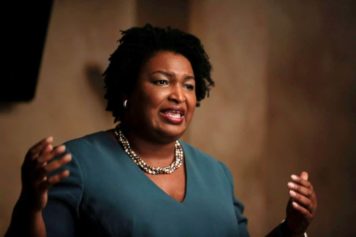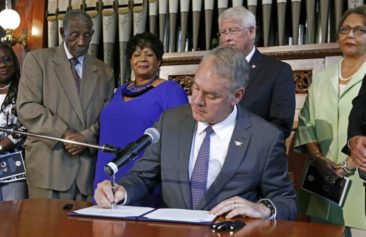
Black homeownership is on the decline.(AP Photo/Elise Amendola, File)
A decade ago, in the midst of a historic financial crisis, numerous critics lined up to lay the cause of the housing meltdown at the feet of the African-American, Latinx and poor communities. The oft-repeated narrative, advanced particularly by Republicans on the congressionally-created Financial Crisis Inquiry Commission (FCIC), contended that affordable housing policies and regulations aimed at more equitable lending—as represented by the 1977 Community Reinvestment Act (CRA) and implemented by government mortgagers Fannie Mae and Freddie Mac — were to blame.
In December 2010, following a report to this effect by the Republican commissioners on the FCIC, then-House Speaker designate John Boehner (R-Ohio) stated, “This eye-opening report details how government mortgage companies played a pivotal role in the financial meltdown by handing out high-risk loans to families who couldn’t afford them.”
Unsurprisingly, the allegations were subsequently found to be baseless, as bipartisan research concluded that government-backed affordable housing practices were “not a significant factor” in the crisis. “In the wake of the affordable housing goals of Fannie Mae and Freddie Mac and the CRA, they get to take shots at poor people,” quipped Rep. Barney Frank (D-Mass), then chairman of the House Financial Services Committee, responding to Republican claims at a 2008 Boston forum on foreclosures. “And let’s be honest, the fact that some poor people are Black doesn’t hurt, either, from their standpoint.
Given the housing meltdown a decade ago was not caused by too many unqualified African-Americans “buying houses they could not afford,” one could casually assume lending practices in the Black community have resumed at a similar pre-crisis rate, or even improved.
They’d be wrong. A Pew Research Center report revealed that, in 2005, African-Americans in the US were roughly 1.7 times more likely to have their conventional mortgage applications denied than their white counterparts. A decade later, in 2015, African-Americans were more than 2.5 times more likely than white applicants to have their applications denied. The metropolitan area of Atlanta mirrors this 2015 national average, while Mobile, Alabama, weighs in at a nation-high 5.6.
“It’s a sad state of affairs,” offered James E. Clingman, economist, professor and journalist. “If we look back at Black business history, we can see that Black folks have obviously been screened out, left out and discriminated against when it comes to credit, which essentially played a major role in putting us in the economic position which we find ourselves today.”
Lenders can reject a mortgage application for a variety of reasons, including poor credit history and high debt-to-income ratios if it is judged an applicant does not make enough income given her or his level of debt. Pew reported that credit is the most commonly cited reason of denial by lenders for African-American applicants. However, this cannot be independently verified, given that, unlike income, debt-to-income ratios, the size of a loan, and racial demographics, banks have successfully blocked efforts to require them to report an applicant’s credit score to the government.
“Many of these banks have put Black people in a catch-22,” said Clingman. “You can’t get credit because you have no net worth, and you have no net worth because you can’t get credit to buy a home, which would increase your net worth.”
The banks see it differently. “No data set can satisfactorily explain all underwriting or pricing decisions,” stated the American Bankers Association in their April 2017 report. “For many years, HMDA (Home Mortgage Disclosure Act) data have been used to identify possible instances of illegal discrimination” and “regulators have long noted that HMDA data alone cannot be used conclusively. There can be legitimate, necessary, and non-discriminatory factors — unobtainable via HMDA data — involved in underwriting or pricing decisions, and such information, when reduced to individual data points, will be of limited use in understanding credit decisions.”
The feds aren’t offering any help. The Trump administration has yet to pursue any racial discrimination cases against lenders, while simultaneously relaxing CRA compliance standards. Before that, the Obama administration was almost as bank-friendly as 99 percent of financial institutions rated satisfactory or outstanding based on compliance inspections under the CRA.
Still, such entities, both public and private, regularly tout home ownership as the basis for wealth and financial stability in America. Unfortunately, African-Americans are struggling in all of these categories, as wealth and income inequality are the highest they have been since 1928, with the gap in median household incomes between whites and African-Americans increasing from $19,000 in 1967 to $27,000 in 2012. Consistently, the racial homeownership gap is currently greater than it was in the 1920s as well.
Some maintain that disproportionate mortgage denials by race and insufficient anti-discrimination regulations by the government have greatly contributed to these persistent gaps.
“The fact that housing finance was at the center of the 2008 financial crisis highlighted yet another problem in the longstanding history of private and governmental racial discrimination in access to housing finance and the resulting economic inequality by race,” recently wrote Emma Coleman Jordan, law professor at the Georgetown University Law Center. “Who is responsible for ensuring that home ownership, the centerpiece of middle- and working-class wealth potential, is financed with stable, suitable financial products that lead to eventual ownership?” Coleman asked, before answering her own question. “A central role of government is to mediate the market forces that manipulate the deep longing for participation in home ownership as a fundamental marker of economic citizenship.”
Such participation has dropped dramatically since the housing crisis. Pew reported that in 2015 only 132,000 African-Americans applied for conventional loans, a sharp decrease from 1.1 million in 2005. Also, in 2005, nearly 10 percent of conventional mortgage applications came from Black households while, in 2015, less than 4 percent did.
Given these numbers, Clingman proposed it is “really incumbent upon the consumers to take some of these issues into our own hands.” Referencing the recent #BankBlack movement, where African-American consumers transferred millions to Black-owned banks nationwide as a “nice first step,” the economist promoted the need for a “reciprocal movement among the Black banks, who really got a windfall in deposits, to develop special kinds of lending programs for Black people.” Upon acknowledging these institutions are subject to the same regulations as other institutions, Clingman suggested “there are creative financing initiatives that could be executed to ensure reciprocity for those deposits” before pointing to the Collective Empowerment Group (CEG), a Maryland-based community organization that effectively halted redlining in its midst.
In the early 1990s, a sizable collective of churches in Prince Georges County, Maryland, and the nearby metropolitan Washington area organized around redlining and other inequitable banking practices affecting their members. A representative group of pastors met with 16 banks and implemented covenants that largely ensured their churches and congregation members would benefit from more equitable financial services. After partnering with numerous Black banks and over two dozen organizations for a wide range of products and services for its increasing membership, CEG subsequently evolved beyond church doors into a community economic empowerment group promoting homeownership preservation, financial literacy, education, health care, inclusive public policy and public safety. “They’ve been doing this for 20 years,” said Clingman, noting how CEG “leverages their collective numbers for reciprocity with the banks that they deal with, both Black and white.”
“We always say, ‘well, they’ve taken our community,’” Clingman said, referring to ongoing gentrification in major cities across the nation. “No, it’s not ours, we don’t own it,” he stressed, promoting the need for increased financial literacy in the Black community to understand such communal pitfalls as renting versus owning property. “We just have to be more informed and more willing to work collectively, like CEG, to leverage for reciprocity and not allow ourselves to be run over by these banks. There’s no redlining in the area where CEG is, and, since they started, they have generated about 300 million dollars in mortgage and business loans.”
“Now that,” added Clingman, “is a good model to follow.”


